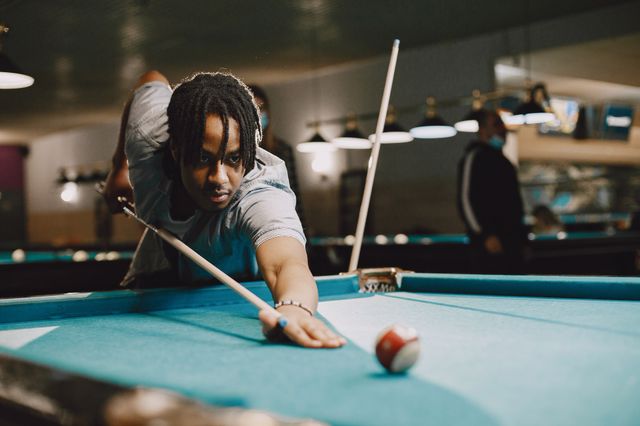Pool cues are made by hand. The materials used in the process of making a pool cue include wood, cork, fiberglass and graphite.
Pool cues are composed of two parts – the shaft and the butt. They are designed to be equal in length so that they can be balanced on the table. The shaft is made of wood or sometimes fiberglass while the butt is usually of graphite or cork with a small amount of fiberglass mixed in.
The shaft is made of wood or sometimes fiberglass while the butt is usually of graphite or cork with a small amount of fiberglass mixed in.
Pool cues are made from a variety of woods, with the most popular being maple. They are then coated with a thin layer of lacquer and soaked in water for hours to make them easier to work with.
The process begins by cutting the wood into straight strips that are the same width and length. These strips are then glued together to form a long, thin plank. This plank is then cut into smaller pieces that will be used as the shafts of the cue. The shafts are also cut from a single piece of wood that has been shaved down until it is just big enough for one side to fit over another piece of wood that will be used as a butt cap.
The butt cap is drilled through and a hole is drilled in the center so it can hold an insert or fer
Pool cues are made by hand, but in a factory setting. There are a few steps involved in the process.
The first step is to cut the wood. This is done with a circular saw and then the wood is shaped into a tube by using a band saw. The next step involves sanding the wood, which removes any rough edges and gives it an even surface. Then, the surface of the cue is coated with varnish so that it doesn’t absorb moisture from humid air or water from rain or sweat from your hands. Finally, an artist paints on it to give it its final color scheme and design before packaging for shipping out to customers around the world.
What are professional pool cues made of?
The material that a pool cue is made of has a huge impact on the performance of the cue.
A professional pool cue usually has a fiberglass shaft, fiberglass wrap, and phenolic resin butt cap. The material is woven together to create a dense and sturdy structure. The butt cap is where most of the weight in professional cues is put, so it must be durable and strong enough to withstand extreme pressure without breaking or cracking.
The design also plays an important role in how well the cue performs. Professional pool cues are designed to have a low center of gravity for better balance and control during play. This makes them easier to shoot with precision shots that require more skill than luck.
Cues are made of a variety of materials, but the most common are wood, fiberglass, and carbon fiber.
The most common cues are made of wood. The best wood to use is hardwood. The thickness of the cue should be at least 1/8 inch.
Fiberglass cues can be used for low-end cues and they come in a variety of colors. Carbon fiber cues are more expensive than wood or fiberglass cues, but they offer better performance and durability because they have an extremely high strength-to-weight ratio.
Professional pool cues are made of high-quality materials that are resistant to wear and tear. There is a wide variety of materials used to make professional pool cues, including:
-
Wood: Maple, walnut, purpleheart and more.
-
Carbon fiber: Carbon fiber is a popular material for its durability and strength.
-
Aluminum: Aluminum is durable and lightweight.
What are cheap pool cues made of?
Cheap pool cues are usually made of wood, plastic, or metal. They are usually inexpensive and can be found at most pool stores.
Cheap pool cues are often used by beginners and intermediate players because they don’t cost much and provide a good quality for the price. However, these cues can break easily and aren’t always sturdy enough to use in high-level play.
A cheap pool cue is not always a bad choice; however, it is important to know what you’re getting in return for the price you pay.
There are many materials that are used to make pool cues. Some of the most common materials are wood, plastic, and metal.
The most common material used to make pool cues is wood. This is because it is easy to find, it’s affordable, and it has a good grip on the stick. It can also be dyed in different colors for a more personalized cue.
There are other materials that can be used as well such as plastic and metal. These materials have their benefits and disadvantages compared to wood but they tend to be more expensive than the first two options mentioned above.
Pool cues are typically made of wood, but the material can vary depending on the style.
Pool cues are typically made from either a hardwood or a composite material such as graphite and fiberglass. The top layer of a pool cue is usually made of wood, which is coated in resin or lacquer for protection and to improve performance.
What is the best material for a pool cue?
Pool cues are made of different materials such as wood, metal, and plastic. Each material has its own advantages and disadvantages.
The best material for a pool cue is going to be determined by the player’s preference. There are pros and cons to each type of material so it is important that the player has a good understanding of these before making their decision.
There are many factors that go into determining what is the best material for a pool cue. The most important factor is going to be the player’s skill level because they will need to know how hard they can hit with each type of cue stick.
Cues are typically made of wood, but they can also be made of other materials such as metal or plastic. The material that is best for a pool cue is dependent on the player’s preference and the type of game they play.
The material that is best for a pool cue is dependent on the player’s preference and the type of game they play. The most common materials used to make cues are wood, plastics, metals and combinations thereof.
There are many different factors to consider when determining what material would be best for a pool cue. These factors include weight, feel, durability and cost.
A pool cue is a long, straight stick with a rounded end meant for playing pool. A pool cue is typically made of wood and has a leather-wrapped handle.
The best material for a pool cue is typically wood, but there are some exceptions to this rule. For example, if you play in an area with high humidity levels, then it would be best to use an exotic wood like Bubinga or African Blackwood because they are resistant to the effects of moisture.
The most important factor when it comes to what material your pool cue should be made out of is the weight: heavier cues tend to provide better control and accuracy on the table.
Do graphite pool cues warp?
Graphite pool cues warp. That’s a fact. But there are some things you can do to prevent this from happening. If you have a pool table, then here are some tips on how to keep your cues from warping:
– Clean the table with a vacuum cleaner or wet cloth every day before you use it
– Make sure the table is level and doesn’t have any bumps in it that could cause warping
Graphite pool cues are used by many pool players and billiard enthusiasts. They are made from a material called graphite, which is a type of carbon. The question is whether graphite cues warp, or if they can be bent and straightened back to normal.
Graphite pool cues are not prone to warping because they can be reshaped easily when heated up to about 400 degrees Fahrenheit. However, it is still important for players to take precautions and keep their cue in good shape.
The answer is yes, but it depends on the type of cue you have. Graphite cues can warp if they are bent too much or heated up too high, but this distortion is easy to fix with a little bit of heat and pressure.
Graphite pool cues warp. Graphite is a soft material that is used to make pool cues and other related products. It is made from the ground up of thin sheets of pure carbon, which are then stacked and heated until they fuse together.
When graphite pools cues are heated, the carbon atoms in the material expand, causing it to become more flexible and less dense than it would be otherwise. This means that graphite pool cues will lose their shape over time and can warp in extreme conditions like humidity or heat.


